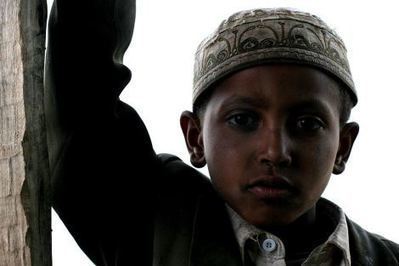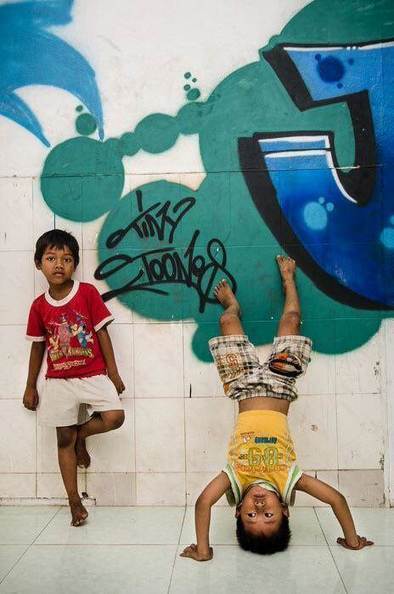"Life imitated art in early 1980 when South African school children, fed up with an inferior apartheid-era education system, took to chanting the lyrics of Pink Floyd‘s 'Another Brick in the Wall.' The song, with its memorable line stating, “We don’t need no education,” had held the top spot on the local charts for almost three months, a total of seven weeks longer than it did in America. By May 2, 1980, the South African government had issued a ban on 'Another Brick in the Wall,' creating international headlines."
Get Started for FREE
Sign up with Facebook Sign up with X
I don't have a Facebook or a X account
 Your new post is loading... Your new post is loading...
 Your new post is loading... Your new post is loading...

Jelel Ezzine's curator insight,
March 25, 2016 3:13 AM
What made the world the way it is? The spread of people, ideas and goods--Geographers refer to this as diffusion and these 5 podcasts all center on what factors promote the spread of some phenomena, and what obstacles and barriers exist to the diffusion of others.
Tags: podcast, medical, diffusion, culture, popular culture, globalization. 
Trish Harris's curator insight,
March 31, 2016 7:40 AM
What made the world the way it is? The spread of people, ideas and goods--Geographers refer to this as diffusion and these 5 podcasts all center on what factors promote the spread of some phenomena, and what obstacles and barriers exist to the diffusion of others.
Tags: podcast, medical, diffusion, culture, popular culture, globalization. 
MsPerry's curator insight,
March 31, 2016 12:57 PM
What made the world the way it is? The spread of people, ideas and goods--Geographers refer to this as diffusion and these 5 podcasts all center on what factors promote the spread of some phenomena, and what obstacles and barriers exist to the diffusion of others.
Tags: podcast, medical, diffusion, culture, popular culture, globalization.
Avery Liardon's curator insight,
March 23, 2015 9:48 PM
Unit 3: Shines insight on stereotypes that are commonly used throughout the world. Reading this article really made me think about stereotypes that are so commonly used they are considered acceptable. It's a ridiculous idea to think that all people under a culture act and behave the same way.
Emily Coats's curator insight,
March 24, 2015 12:06 PM
UNIT 3 CULTURE This article is written to compare and contrast various ways to teach young school children about global cultures. On one hand, we can relate all cultures to each other, due to their common goals and views. For example, all families around the world aim to do what's best for each other, love and cherish one another, and try their hardest to succeed economically. On the other hand, cultures are extremely different around the world, with different music, clothing, and underlying views on life. We can continue to say that popular culture has diffused so greatly, with advanced technologies and means of transportation, so it has influenced and homogenized our landscape quite a bit. Folk culture is obviously still a powerful force, but popular culture does have some effects around the world. I believe that children need to understand the importance of maintaining diversity thy preserving folk culture but they also need to acknowledge the pros and cons of the global diffusion of popular culture and how it connects us at a global scale.
Danielle Smith's curator insight,
April 12, 2015 12:21 AM
I think Teaching Cultural Empathy: Stereotypes, World Views and Cultural Difference is a helpful article for teachers to read. This article considers ideas I constantly come back to, whilst collecting resources and ideas for teaching students about cultural diversity and identity. How do I teach students, that ‘people and cultures are different all over the world’ (Dixon, 2015, April 2), but also the same? Dixon suggests that we need to teach that people and cultures worldwide are the SAME and DIFFERENT simultaneously. In this way, students can appreciate the rich diversity of cultures and societies, whilst at the same time learning values of humanity and empathy, which unite us all.
I believe by recognising and appreciating the rich cultures of students in the classroom, we can explore and learn about cultural diversity in an honest, rich and non-stereotypical way and allow students to feel valued at the same time. In addition, as students know each other, this helps them relate to ‘people from other places, who speak other languages’ and follow different religions to their own (Dixon, 2015, April 2). Furthermore, this should help increase intercultural understanding in the classroom by developing a ‘socially cohesive’ environment that ‘respects, and appreciates cultural, social and religious diversity’ (MYCEETA, p. 7).
References Dixon, S. (2015, April 2). Teaching cultural empathy: Stereotypes, world views and cultural difference. National Geographic. Retrieved April 7, 2015, http: http://blog.education.nationalgeographic.com/2015/02/04/teaching-cultural-empathy-stereotypes-world-views-and-cultural-difference/
Ministerial Council on Education, Employment, Training, and Youth Affairs. (2008, December). Melbourne declaration on educational goals for young Australians. Melbourne: Author.
Mark Hathaway's curator insight,
November 10, 2015 6:19 AM
Why do Indians love Cricket? As with most modern day countries, colonialism has something to do with it. However, the British never intended to promote Cricket in India. It was the local elite of India that first pushed to incorporate the game into Indian culture. Desperate to gain the prestige that the British attached to the game, the elite began the practice of playing Cricket in India. In the years following independence, the game has spread to the other classes of Indian society. The game has become the national pastime for the nation.
Benjamin Jackson's curator insight,
December 14, 2015 11:52 AM
this is an interesting reason for a game to spread. it was a game played by the elite, so it never really lost the appeal of being a sport of the rich.

Martin Kemp's curator insight,
December 17, 2015 3:30 PM
i have tried to watch a cricket match before but it seemed so odd, i dont really fully understand the game but the people playing (especially inians) were playing more than a game, for them it seemed like they were playing for their country and it was a great honor to them. unlike a sport like soccer where people play for other countries teams. |
Genesis Orellana Cabrera's curator insight,
January 18, 2018 7:36 PM
This article shows how background and place can impact a person's career. Tuy Sobil did not enjoy living in the U.S, when he was deported to Cambodia he began to help others through dancing. Geography has a lot to do with this as culture is what forms a person's identity, then it become cultural geography. This man was able to obtain a second chance in a place in which accepted Hip Hop, through this, others started to follow, for instance, the guy who gave up drugs in order to dance with Tuy Sobil.
Shane C Cook's curator insight,
May 27, 2015 9:05 AM
This superhero is more than just something to bring joy to children in Pakistan. This hero empowers women to think they can be strong like the Burka Avenger. 
Chris Costa's curator insight,
November 30, 2015 9:51 AM
This is an awesome, heartwarming story, and I highly recommend people to watch the trailer for the show offered on the website- it seems very cool, and like something kids will actually want to watch (unlike a great deal of educational television). For a nation that is plagued by such a great deal of bigotry and gender inequality- with female infant mortality rates contributing to a gender distribution of 108 men to 100 women- it is so good to see a program such as this being released from Pakistan. Young Muslim women are so deprived of positive and powerful female role models, allowing for the continued systematic abuse and mistreatment of women in many parts of the Middle East, including Pakistan. This show looks promising, from both a critical and humanitarian perspective, although I fear for the lives of its creators and that its showing will be suppressed in the very nations that need it the most. Terrorist organizations and religious extremists fear education and empowerment more than any army, as only those two factors can truly combat these movements effectively, and they will show no mercy should they ever be given the chance to cease the production of this program. I applaud its creators for their bravery, and hope that they are able to get their message across.
Mark Hathaway's curator insight,
November 10, 2015 6:19 AM
Why do Indians love Cricket? As with most modern day countries, colonialism has something to do with it. However, the British never intended to promote Cricket in India. It was the local elite of India that first pushed to incorporate the game into Indian culture. Desperate to gain the prestige that the British attached to the game, the elite began the practice of playing Cricket in India. In the years following independence, the game has spread to the other classes of Indian society. The game has become the national pastime for the nation.
Benjamin Jackson's curator insight,
December 14, 2015 11:52 AM
this is an interesting reason for a game to spread. it was a game played by the elite, so it never really lost the appeal of being a sport of the rich.

Martin Kemp's curator insight,
December 17, 2015 3:30 PM
i have tried to watch a cricket match before but it seemed so odd, i dont really fully understand the game but the people playing (especially inians) were playing more than a game, for them it seemed like they were playing for their country and it was a great honor to them. unlike a sport like soccer where people play for other countries teams.
Katie Kershaw's curator insight,
April 17, 2018 11:27 PM
Today’s world is so globalized it’s pretty inevitable that cultural aspects are going to be exchanged. In this case, a man who grew up in the U.S. became a well known break dancer, but ended up being deported to Cambodia after being involved with a gang. What is interesting about his story is that he had never lived in Cambodia outside of infanthood, so he had to adjust to a whole new culture. He was approached by some kids who wanted him to teach them to break dance, which is an American form of dance, and he agreed. He has now been able to use breakdancing as a platform to help at risk kids in the city of Phnom Penh. Kids are able to attend school to learn technology, English, and breakdancing. He ensures that they avoid the negative experiences he had in a gang by teaching them about the dangers of drugs and HIV. It was neat to see Cambodian kids listening to American rap music and breakdancing. This just shows how something from one culture can be taken and used to help people in another culture. I think people often think that change and foreigness are negative, but as in this case, sometimes cultural diffusion is beneficial.

Corey Rogers's curator insight,
December 15, 2018 7:00 PM
It is a unique video that shows how a certain culture in the US can find a home in Cambodia thousands of miles away. It gives an insight of a man from California brings back to Cambodia what he learned from living in the United States. It is a great story of how one man looks to change Cambodia in a positive way.
Stevie-Rae Wood's curator insight,
December 17, 2018 12:58 PM
As crazy as it seems dancing is trying to help kids. A former gang member from Long Beach, California teaches dancing to children at risk in Cambodia. He got deported after being charged with a felony to a country he has never been before. However, he is changing his life around to help change the lives of todays youth through methods that he learned in the states.
|














